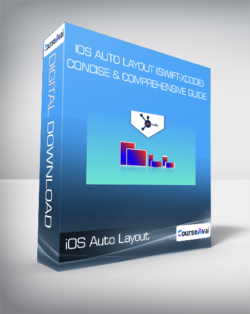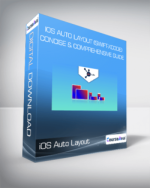Auto Layout allows us to design and laying out UI components within our app that will be responsive to users’ devices form factor and orientation. File size: 1.54 GBPurchase iOS Auto Layout (Swift-Xcode). Concise & Comprehensive Guide courses at here with PRICE $34 $16iOS Auto Layout (Swift-Xcode). Concise & Comprehensive GuideWhat you’ll learnProperly laying out UI components that will adjust to devices sizes and orientation.Get comfortable with auto layout UI using Storyboards.Learn auto layout programmaticallyCourse contentExpand all 19 lectures04:24:51-Introduction04:23:51Why Auto Layout?Preview05:10Introduction to Auto LayoutPreview21:57Identify Auto Layout Common Issue08:32Constraints Priority20:15Orientation Based Layout14:34Proportional Constraints08:45Size Classes: Key Concept08:17Designing Layout with Size Classes16:53Content Hugging and Compression19:44Constraints Runtime Update12:32Programmatic Constraints21:20Layout Anchor18:10Visual Format Language – Key Concept05:01Constraint with Visual Format Language21:08Dynamic Tableview Cell15:26Stackview15:17More Stackview14:28Scrollview16:22-Where To Next?01:00Congratulations and Bonus Offer01:00RequirementsBasic iOS developmentLatest XcodeGet iOS Auto Layout (Swift-Xcode). Concise & Comprehensive Guide downloadAuto Layout allows us to design and laying out UI components within our app that will be responsive to users’ devices form factor and orientation. It will dynamically calculate the positions and sizes of the UI components automatically to deliver a consistent users experience in iOS app across devices, and with more and more devices form factors being introduced, mastering auto layout is critical and as developer we have to be really comfortable dealing with this.Auto layout in iOS uses a constraint-based approach, which means we are setting constraints for each of the UI components that will adapt to both external (ie device size, rotation) and internal (ie internationalization) changes. In this course we will be using the Xcode storyboard approach as well as programmatic way using Swift to set our layout constraints. In some cases programmatic way might be the only way especially if we want to change the constraints at runtime.There are a lot to cover on this course:Orientation based layoutSize classesConstraint priorityProportional constraintsContent hugging and compressionRuntime updateLayout anchorNSLayoutConstraintVisual Format LanguageDynamic tableview cellStackviewScrollviewBy the time we are done, you should be comfortable dealing with auto layout in your project.Who this course is for:Beginner and Intermediate iOS DeveloperGet iOS Auto Layout (Swift-Xcode). Concise & Comprehensive Guide downloadPurchase iOS Auto Layout (Swift-Xcode). Concise & Comprehensive Guide courses at here with PRICE $34 $16
 Jerry Andrus – Lifetime of Magic 3
₹2,656.00
Jerry Andrus – Lifetime of Magic 3
₹2,656.00
 The Art of Investing Lessons from History’s Greatest Traders
₹2,656.00
The Art of Investing Lessons from History’s Greatest Traders
₹2,656.00
iOS Auto Layout (Swift-Xcode). Concise & Comprehensive Guide
₹2,656.00






